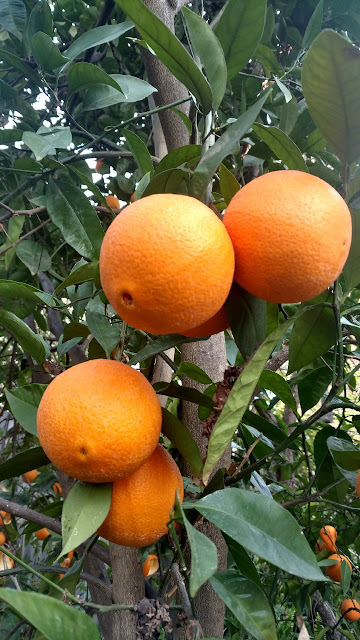
|
|
More than 80 pounds of oranges have been harvested from this small tree. (Photos: Debbie Arrington)
|
Judging by backyard citrus trees, 2021 looks like a heavy year.
On tree after tree in garden after garden, ripe oranges pack limbs, sagging from the weight. Mandarins, tangerines, grapefruit and lemons have been bountiful, too.
I know my own little Washington navel had a banner harvest. This week, I harvested more than 80 pounds of very large oranges from a tree barely 12 feet tall.
Usually, I let the oranges stay on the tree a little longer, harvesting as needed. But critters had discovered my tree and were treating it like an all-night fresh-fruit buffet. They’d eaten more than 20 oranges before I started picking.
At least I knew they were ripe.
Several other Sacramento-area gardeners have told me that their citrus trees are having good seasons, too.
But why?

|
|
How to tell when an orange are ripe? Pick and taste it.
|
Citrus trees are notorious for one heavy year, followed by a year with little fruit. It’s the sort of habit that can bankrupt farmers. For backyard gardeners, it’s more annoying and perplexing than problematic.
Back in 1994, farm adviser Peggy Mauk and Tom Shea of the UC Cooperative Extension explained this weird citrus trait in their horticultural notes, “Questions and Answers to Citrus Management,” an update and compilation of UCCE master gardener and farm expert advise still available on the UCCE website. (Find it here:
https://ucanr.edu/datastoreFiles/391-272.pdf
.)
“Certain citrus types such as Valencia oranges or some mandarins have a tendency to have a year with heavy fruit production followed by a year with sparse production,” they wrote. “This is called alternate bearing.”
Is there a way to even out the harvests?
“You can reduce the potential of a tree to alternate bear by reducing the fruit load on a heavy fruit set year by thinning out some of the fruit,” they advised. “Pruning the tree will also help to offset alternate bearing. Also, fertilize less in light years and more in heavy years so that the tree’s needs are met according to the demands of the fruit load. Lastly, do not allow the old fruit to stay on the tree longer than necessary.”
That still may not be enough.
“Despite using these strategies, some varieties will just alternate bear,” they concluded.
Of course, irrigation plays a role, too. Because citrus takes so long to develop, the water a tree received when it was first setting fruit may help determine the size of the harvest. The more water, the more fruit a tree may try to set.
I suspect heavy rains back in late 2019 had something to do with our current citrus bonanza.
Although 2020 was a relatively dry year, the winter of 2019-20 – when a lot of the citrus we’re picking now was first forming – came after a very wet year. With that extra water, trees also grew a lot in 2019, giving them more room to bear fruit.
The important thing is to pick the fruit in a timely fashion, according to the UCCE experts. Citrus won’t get sweeter after harvest, so leave it on the tree until “ready.” (How to tell? Pick one and taste it.) But oranges allowed to hang around on the tree until March or April may hamper the tree’s spring bloom – and next year’s crop.


